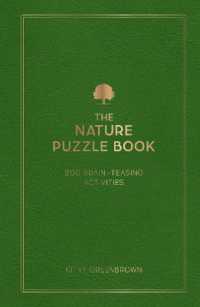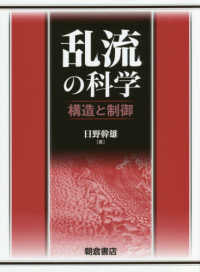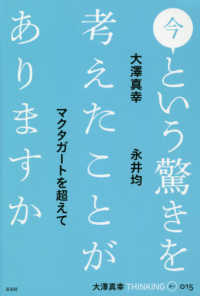Full Description
Conservation Science is a rather innovative application of instrumental analysis with steadily increasing importance. Although the first attempts for preserving material from the cultural heritage on a scientific basis are found in the 19th century pioneer chemistry years, only the use of sophisticated physicochemical techniques results in effective identification and deterioration studies of monuments and objects, and in reliable intervention procedures.
This volume allows to gain solid knowledge and improved skills on the ways separation schemes and diagnostic methodologies are applied in the safeguarding and authentication of tangible works of art; as well as on the modes of implementing novel safeguarding practices built on well-established principles - such as the use of laser in the decontamination of objects. All techniques are covered at a state-of-the-art level; while selected applications permit addressing major groups of materials and artefacts.
Conservation Science is nowadays taught at master's level in all developed countries, and museum laboratories increasingly adopt scientific approaches in their restoration initiatives. The book is intended as a valuable tool for students and professionals active in these frames. In addition, it provides an indispensable manual for participants in the specialized intensive courses, which are systematically offered by the authors under the auspices of the relevant European network.
Contents
General Considerations: On materials and artefacts.- Separation Techniques: High Performance Liquid Chromatography (HPLC) and Gas Chromatography (GC).- Capillary Electrophoresis.- Identification Techniques I: Imagine techniques.- The role of microscopy techniques in the study of cultural heritage materials.- Infrared and Raman Spectroscopy.- Solid state NMR.- Identification Techniques II: X-ray techniques and X-ray fluorescence with portable systems.- The Small Angle Scattering technique: an effective tool in the structural investigation of archaeologically relevant specimens.- Energy dispersive X-ray diffraction in cultural heritage science: The winning duo of structural and elemental analysis.- Particle induced X-ray emission spectroscopy in conservation science.- Atomic absorption spectroscopy in conservation science.- Thermal analysis techniques.- Applying the Techniques on Materials I: Identification of natural dyes in 13th Century textiles by HPLC-DAD detection.- Identification of natural dyes by RP-HPLC-DAD and natural dyeing procedures.- Liquid chromatographic analysis of ancient Egyptian organic material.- Binding media identification in art objects by gas chromatography-mass spectrometry.- FT Infrared Spectroscopy as an identification tool in polychrome artefact studies.- Solid state NMR to characterize paper and parchment samples from a 16th century book.- Case studies on textile studies with Scanning Electron Microscopy.- Physicochemical methods of analysis for the study of archaeological textiles.- Identification of purple by means of Pyrolysis Gas Chromatography /Mass Spectrometry.- Applying the Techniques on Materials II: The application of back-scattered scanning electron microscopy to unravel building stone decay mechanisms in urban environments.- Application of microscopy, X-ray diffractometry (XRD) and stable-isotope geochemistry in provenance determination ofthe white marbles used in the ancient Great Theatre of Larisa, Thessaly, Greece.- Case studies: Investigation of mortars by Infrared and Raman Spectroscopy.- Mortars-Thermal analysis.- Electrochemical Impedance Spectroscopy measurements for the corrosion behaviour evaluation of epoxy - (organo) clays nanocomposite coatings.- Study of Vatican masterpieces.- Laser applications in cultural heritage preservation.
.








